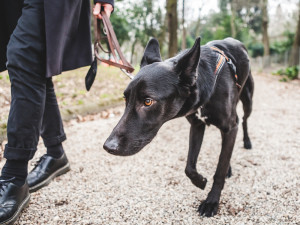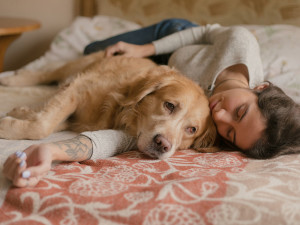Why Is Your Puppy Such a Shy Guy?
It actually has a lot to do with genetics.

Share Article
Your pup’s practically fresh out of the womb, and you’ve been nothing but encouraging to them, but for some reason they still hover by your feet instead of hanging with their peers. First of all, there’s probably nothing to worry about: Just like people, some dogs are naturally more extroverted than others. So, don’t blame yourself or wonder what went wrong because genetics play a big role in a dogs’ temperament — and your pup can live a full, happy life, anyway.
If you have siblings (or keep up with the Kardashians), you’re probably not even a little shocked that littermates can grow into adults who are wildly different from each other. Siblings, whether human or canine, aren’t clones — even identical twins have differences in their DNA. No matter how similar the upbringing, minor differences in siblings’ genetic makeup and their time in the womb account for major differences in behavior. Below, find out some scientific reasons that some puppies are shy or fearful, while others are more outgoing.
The Genetics of a Shy Puppy
You’re probably acquainted with physical variation in dogs, from flat-nosed Pugs to skinny-muzzled Salukis. But, this genetically mediated variation is equally true of behavioral predispositions. These differences are all thanks to the genetic makeup of each dog, which is unique to that individual. After all, the point of sexual reproduction — an inefficient and messy process (genetically speaking) — is variation.
Each parent contributes one strand of DNA to the double helix that makes up each chromosome, and the strands link up in unique ways each time a new life is created. That said, every individual is the result of a unique combination of genes. In an environment with a range of conditions — perhaps a drought one year and floods the next — genetic variation increases the odds that some individuals will survive even if others perish, thus ensuring the continuation of at least some individuals of their particular species.

According to research on personality done over the past 30 years, one of the most heritable behavioral characteristics is called the “shy-bold continuum,” which has been found to be a relatively stable aspect of personality in some primates, cattle, people, and dogs (to name a few).
It appears as though different points on the “shy-bold” spectrum are advantageous at different times. For example, primatologist Steve Suomi has found that in some conditions, shy male rhesus monkeys have higher reproductive success than bold ones. The shy males wait longer to leave their natal troops and arrive at a new troop larger and better able to hold their own when challenged by established males.
You can imagine how, in some contexts, the ancestors of domestic dogs might be best served by boldness (being the first to venture near a human settlement) or by caution and timidity (steering clear of lions).
Different Experiences in the Womb
Beyond an understanding of the role of genetics, research is increasingly focused on the effect of in-utero experiences on the development and, ultimately, the health and behavior of an individual.
Until recently, developmental considerations have focused on the influence of genetics and the environment during “early development” — the old nature/nurture argument. The period defined as “early development” began at birth and followed an animal through infancy, childhood, adolescence, and adulthood. But there’s also the important influence of in-utero experiences, an environment never before considered as having an effect on an adult animal.
Dog moms shape their puppies’ rhythms.
In general, the influence of a mother’s experience on her fetus is profound: Her sleep pattern teaches the developing pup about the cycle of day and night. Her food preferences influence her puppy’s after birth. If the mother is seriously deprived of food, her pup will be predisposed to diabetes and high cholesterol as an adult.
Fearful moms can have fearful puppies.
Most relevant to a shy puppy, a mother suffering from extreme anxiety puts her offspring at high risk of being anxious and fearful, even as an adult. Apparently, high levels of the stress hormone cortisol produced by the mother result in fewer cortisol receptor cells in the pup. This low number of receptor cells means that the pup’s brain is unable to perceive and respond to high levels of cortisol in their own body until the system is overloaded with it. Then the brain goes on red alert, sending the emotions into full panic mode, even in situations that would be only mildly stressful for an average individual.
How resources are shared in the womb.
In addition to the significant effect of a mother’s influence on her young, we also know now that each individual’s experience within the uterus is different. Minor differences in nutrients, for example, have long been known to be a factor in major differences in the size and health of animals within a litter. Even genetic clones — identical twins, for example — aren’t behaviorally identical. Though they may look alike, they usually have remarkably different personalities. Since they developed with the same set of genes, only in-utero experiences can account for their behavioral differences. Developmental psychologists are learning that for twins, development in the womb is a kind of dance between the two that, by the time they are born, has shaped their personalities.
Their littermates play a role, too.
Another example of the influence of in-utero development is what’s called “androgenization.” In this phenomenon, females in a litter are permanently affected by the androgen produced by male puppies surrounding them within the uterine horns. Androgen is the precursor to testosterone, and females who are “bathed” in it, perhaps because of their placement between a large number of males, tend to behave differently than other females once they develop into adults.
And so, even prior to birth, profoundly different experiences could have shaped puppies from the same litter. The combination of different genetic blueprints and different experiences inside the womb resulted in two dogs with very different personalities and tolerances. Even though they have grown up together, those beginnings mean that a similar environment will affect them in different ways as they continue to develop. Your shy puppy will probably always be more cautious than other outgoing pups — because much of who they are was established before they were born.

Patricia McConnell, PhD
Patricia McConnell, PhD, is an animal behaviorist and ethologist and an adjunct associate professor in zoology at the University of Wisconsin, Madison, as well as the author of numerous books on behavior and training.
Related articles
![A shy looking dog sitting on a couch.]()
Some Dogs Are Scaredy Cats — And That’s OK
Not all fearful dogs have been mistreated.
![Muscular white pit bull stands on couch, looking out window to sunny fall day.]()
Separation Anxiety in Dogs
Does your dog freak out when you head for the door? Here’s some advice.
![Afghan hound dog mid jump in an open grass field]()
Overexcited Dog? How to Calm A Dog Down
If your dog loses their sh*t over anything—from a squirrel to a guest. Here are some tips to curtail that.
![Two hands holding a very young tan and white puppy up in front of a lake landscape]()
How to Socialize a Puppy
Everything you need to know to get your new addition off to a good start.
![Dog playing with orange ball toy at the beach on a sunny day]()
A Tail-Wagging Dog Isn’t Always a Happy Dog
This body language is not as simple as you probably think.
Does Your Dog Need Anti-Anxiety Meds?
How to cope with dog anxiety—from training to medication.










